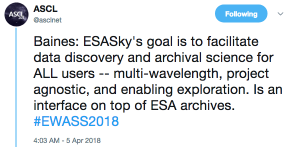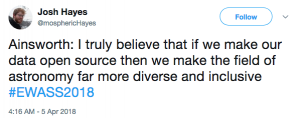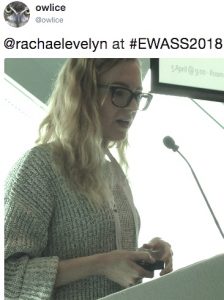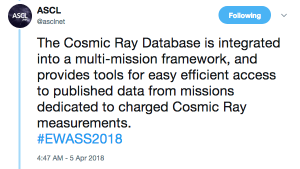This is the fourth in a series of posts on the six-session Software in Astronomy Symposium held on Wednesday and Thursday, April 3-4 at the 2018 EWASS/NAM meeting.
BLOCK 4: Open & Transparent Data Services
Astronomy leads most sciences in providing many open services, particularly data and ways to get access to and u se data. This session, moderated by Andy Pollock (USheffield, UK), highlighted some of the new and ongoing services available to not just professional astronomers, but also to students and other interested parties. Debbie Baines (ESA, ES) opened the session with her presentation ESASky version 2: the next generation, which included a live demonstration of this incredible resource. ESASky allows searching for any astronomical object and offers viewing it in different wavelengths. It is very fast, too; Baines loaded images from Herschel, XMM, Chandra, and HST in her live demo. It offers relevant links to SIMBAD, such as to papers, and one can pull up research literature from ADS in ESASky, too.
se data. This session, moderated by Andy Pollock (USheffield, UK), highlighted some of the new and ongoing services available to not just professional astronomers, but also to students and other interested parties. Debbie Baines (ESA, ES) opened the session with her presentation ESASky version 2: the next generation, which included a live demonstration of this incredible resource. ESASky allows searching for any astronomical object and offers viewing it in different wavelengths. It is very fast, too; Baines loaded images from Herschel, XMM, Chandra, and HST in her live demo. It offers relevant links to SIMBAD, such as to papers, and one can pull up research literature from ADS in ESASky, too. Rachael Ainsworth (UMelbourne, AU), originally scheduled to give the first presentation, followed Baines; her presentation, Open Science in Astronomy, gave an overview of openness in astronomy. She pointed out that astronomy is better at open science than many other fields, crediting, among other services, arXiv and GalaxyZoo. She covered some of the challenges
Rachael Ainsworth (UMelbourne, AU), originally scheduled to give the first presentation, followed Baines; her presentation, Open Science in Astronomy, gave an overview of openness in astronomy. She pointed out that astronomy is better at open science than many other fields, crediting, among other services, arXiv and GalaxyZoo. She covered some of the challenges and shared additional resources that support, encourage, or make open science possible. Jorge Palacios (IFAE, ES), in his talk Astronomy in a Big Data platform, discussed two services, Cosmohub, a web portal for interactive exploration and distribution of massive cosmological data, and SciPIC (Scientific pipeline at PIC), software for generating synthetic galaxy catalogs using DM simulations. In An Interactive Sky Map based on the Byurakan Plate Archive, Gor Mikayelyan (BAO, AM) shared that the NAS RA Byurakan Astrophysical Observatory in Armenia is making its plate archive, covering 1947 -1991, available online in the BAO Observational Database, which will have the ability to search and select and will allow downloading the plates in different formats. A sky map will show where plates are available. After the last two talks, The ASI Cosmic Ray Database for charged particles data
and shared additional resources that support, encourage, or make open science possible. Jorge Palacios (IFAE, ES), in his talk Astronomy in a Big Data platform, discussed two services, Cosmohub, a web portal for interactive exploration and distribution of massive cosmological data, and SciPIC (Scientific pipeline at PIC), software for generating synthetic galaxy catalogs using DM simulations. In An Interactive Sky Map based on the Byurakan Plate Archive, Gor Mikayelyan (BAO, AM) shared that the NAS RA Byurakan Astrophysical Observatory in Armenia is making its plate archive, covering 1947 -1991, available online in the BAO Observational Database, which will have the ability to search and select and will allow downloading the plates in different formats. A sky map will show where plates are available. After the last two talks, The ASI Cosmic Ray Database for charged particles data by Valeria Di Felice (SSDC/INFN, IT) and Using XML and semantic technologies in astroinformatics to manage data by Guy Beech (UHuddersfield, UK), Pollock opened the floor for discussion and asked whether people could do what they’d like to do as efficiently as they’d like. One answer from the audience was no, because the data are heterogeneous and different ways are required to access them. One pointed observation arising from the back-and-forth was that “radio astronomy is decades behind” in terms of software services, with “thousands of different file formats processed by thousands of different programs”.
by Valeria Di Felice (SSDC/INFN, IT) and Using XML and semantic technologies in astroinformatics to manage data by Guy Beech (UHuddersfield, UK), Pollock opened the floor for discussion and asked whether people could do what they’d like to do as efficiently as they’d like. One answer from the audience was no, because the data are heterogeneous and different ways are required to access them. One pointed observation arising from the back-and-forth was that “radio astronomy is decades behind” in terms of software services, with “thousands of different file formats processed by thousands of different programs”.
Astronomy leads most sciences in providing many open services, particularly data and ways to get access to and u
 se data. This session, moderated by Andy Pollock (USheffield, UK), highlighted some of the new and ongoing services available to not just professional astronomers, but also to students and other interested parties. Debbie Baines (ESA, ES) opened the session with her presentation ESASky version 2: the next generation, which included a live demonstration of this incredible resource. ESASky allows searching for any astronomical object and offers viewing it in different wavelengths. It is very fast, too; Baines loaded images from Herschel, XMM, Chandra, and HST in her live demo. It offers relevant links to SIMBAD, such as to papers, and one can pull up research literature from ADS in ESASky, too.
se data. This session, moderated by Andy Pollock (USheffield, UK), highlighted some of the new and ongoing services available to not just professional astronomers, but also to students and other interested parties. Debbie Baines (ESA, ES) opened the session with her presentation ESASky version 2: the next generation, which included a live demonstration of this incredible resource. ESASky allows searching for any astronomical object and offers viewing it in different wavelengths. It is very fast, too; Baines loaded images from Herschel, XMM, Chandra, and HST in her live demo. It offers relevant links to SIMBAD, such as to papers, and one can pull up research literature from ADS in ESASky, too. Rachael Ainsworth (UMelbourne, AU), originally scheduled to give the first presentation, followed Baines; her presentation, Open Science in Astronomy, gave an overview of openness in astronomy. She pointed out that astronomy is better at open science than many other fields, crediting, among other services, arXiv and GalaxyZoo. She covered some of the challenges
Rachael Ainsworth (UMelbourne, AU), originally scheduled to give the first presentation, followed Baines; her presentation, Open Science in Astronomy, gave an overview of openness in astronomy. She pointed out that astronomy is better at open science than many other fields, crediting, among other services, arXiv and GalaxyZoo. She covered some of the challenges and shared additional resources that support, encourage, or make open science possible. Jorge Palacios (IFAE, ES), in his talk Astronomy in a Big Data platform, discussed two services, Cosmohub, a web portal for interactive exploration and distribution of massive cosmological data, and SciPIC (Scientific pipeline at PIC), software for generating synthetic galaxy catalogs using DM simulations. In An Interactive Sky Map based on the Byurakan Plate Archive, Gor Mikayelyan (BAO, AM) shared that the NAS RA Byurakan Astrophysical Observatory in Armenia is making its plate archive, covering 1947 -1991, available online in the BAO Observational Database, which will have the ability to search and select and will allow downloading the plates in different formats. A sky map will show where plates are available. After the last two talks, The ASI Cosmic Ray Database for charged particles data
and shared additional resources that support, encourage, or make open science possible. Jorge Palacios (IFAE, ES), in his talk Astronomy in a Big Data platform, discussed two services, Cosmohub, a web portal for interactive exploration and distribution of massive cosmological data, and SciPIC (Scientific pipeline at PIC), software for generating synthetic galaxy catalogs using DM simulations. In An Interactive Sky Map based on the Byurakan Plate Archive, Gor Mikayelyan (BAO, AM) shared that the NAS RA Byurakan Astrophysical Observatory in Armenia is making its plate archive, covering 1947 -1991, available online in the BAO Observational Database, which will have the ability to search and select and will allow downloading the plates in different formats. A sky map will show where plates are available. After the last two talks, The ASI Cosmic Ray Database for charged particles data by Valeria Di Felice (SSDC/INFN, IT) and Using XML and semantic technologies in astroinformatics to manage data by Guy Beech (UHuddersfield, UK), Pollock opened the floor for discussion and asked whether people could do what they’d like to do as efficiently as they’d like. One answer from the audience was no, because the data are heterogeneous and different ways are required to access them. One pointed observation arising from the back-and-forth was that “radio astronomy is decades behind” in terms of software services, with “thousands of different file formats processed by thousands of different programs”.
by Valeria Di Felice (SSDC/INFN, IT) and Using XML and semantic technologies in astroinformatics to manage data by Guy Beech (UHuddersfield, UK), Pollock opened the floor for discussion and asked whether people could do what they’d like to do as efficiently as they’d like. One answer from the audience was no, because the data are heterogeneous and different ways are required to access them. One pointed observation arising from the back-and-forth was that “radio astronomy is decades behind” in terms of software services, with “thousands of different file formats processed by thousands of different programs”.Slides from this session
Open Science in Astronomy by Rachael Ainsworth (pdf)
Astronomy in a Big Data platform by Jorge Palacios (pdf)
An Interactive Sky Map based on the Byurakan Plate Archive by Gor Mikayelyan (pdf) | Text (pdf)
The ASI Cosmic Ray Database for charged particles data by Valeria Di Felice (pdf)
Using XML and semantic technologies in astroinformatics to manage data by Guy Beech (pdf) | Paper (pdf)